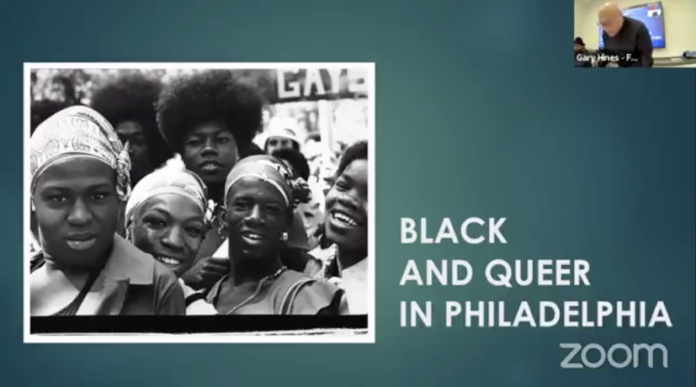This story originally stated that “Black & Queer in Philadelphia: From the 1930s to Today” was sponsored by the Office of LGBT Affairs. The event was actually sponsored by Newspapers & Microfilm Center of the Free Library.
On Feb. 7, the Free Library hosted a lecture by Gary Hines called “Black & Queer in Philadelphia: From the 1930s to Today.” A Philadelphia native, Hines is an activist and historian who has worked with the William Way LGBT Community Center, Philadelphia FIGHT, and a number of other Philadelphia organizations and agencies.
Starting with the 1930s, Hines noted that Black LGBTQ+ life then was extremely furtive — as was nearly all LGBTQ+ life in those pre-Stonewall days. It consisted mostly of private social gatherings of men and women who had a strong social network, hosted in people’s homes; attendance being mostly by invitation only.
Hines said that documentation of LGBTQ+ life in the 30s is hard to come by because media coverage was so scarce, and when there was media coverage, it was often negative and salacious, with such terms as “pansies,” “perverts” and “pedophiles.”
“This sound familiar?” Hines asks wryly.
Hines then shifted the narrative to the 1970s, as Philadelphia’s community struggled to get a gay anti-discrimination ordinance passed in City Council, with similar language being used by the media even then.
“This was typical of the coverage we were still getting at the time,” Hines noted.
Hines then listed a number of social groups that, as the decades passed, took on a more formal existence. These included such groups as the West Set (since most members lived in West Philly), which patterned its functions on high society, and Mox Nix, which also took on charitable causes like needy children and AIDS.
Hines then described Black LGBTQ+ social life from the ’50s through the ’70s.
“Philadelphia was, then, a very segregated town — still is,” Hines said. He pointed out that favored cruising grounds were very racially specific, with white men preferring Judy Garland Park, and Black men preferring Gay Acres, the wooded area behind the Art Museum.
In those early days, there was a large and vibrant gay bar scene that catered to Black men and women, centered mostly in West Philly and north of Market. The north of Market Street establishments fell victim to various development projects, while the West Philly bars closed as the LGBTQ+ social scene gravitated to what became the Gayborhood and surrounding Center City areas with such bars as Allegro II and the Smart Place.
Hines went at some length about the tumult in the community when activists and various progressive groups started protesting racist policies of several gay bars, particularly admission policies that made it clear they did not welcome Black men and women. The protests centered around Kurt’s, the most popular dance club at the time (now long gone), but also included such places as Equus and the DCA (both now also defunct). The protests succeeded enforcing the various bars to adopt more equitable admissions policies.
Hines then proceeded to list various important figures in Black LGBTQ+ Philadelphia history. Some of these included such luminaries as Anita Cornwell, Bayard Rustin, Joe Beam, James Roberts and today’s Malcolm Kenyatta. Hines also named various organizations that have contributed to advancing the Black LGBTQ+ community over the years, such as Colours, Black and White Men Together (BWMT)/ Men of All Colors Together (MACT), Philadelphia Black Pride and BEBASHI.
Hines closed this section by commenting, “Some of these people need historical markers. Certainly Anita Cornwell and Joe Beam deserve markers.”
Hines ended his lecture by discussing Philadelphia’s ballroom scene. The ballroom scene as a whole was widespread before being made famous by Madonna and the documentary “Paris Is Burning.” He pointed out that Philadelphia’s scene is still active and vibrant.
Hines’ lecture was sponsored by Newspapers & Microfilm Center of the Free Library. The lecture in its entirety is available on the History at the Free Library of Philadelphia Facebook page.
